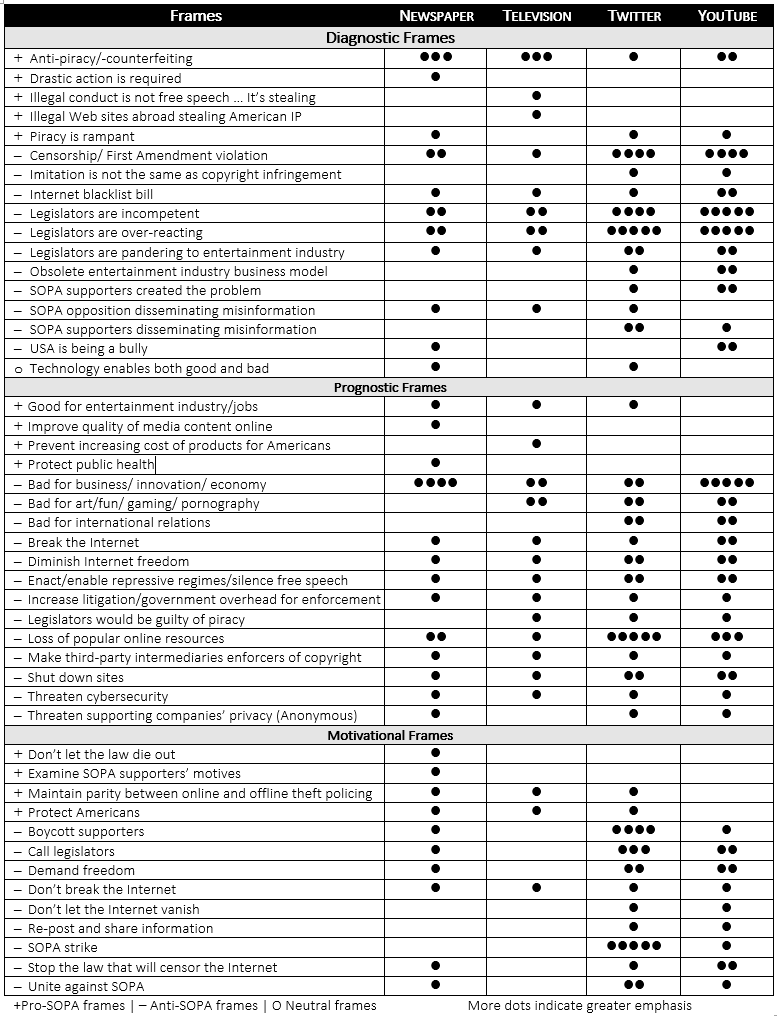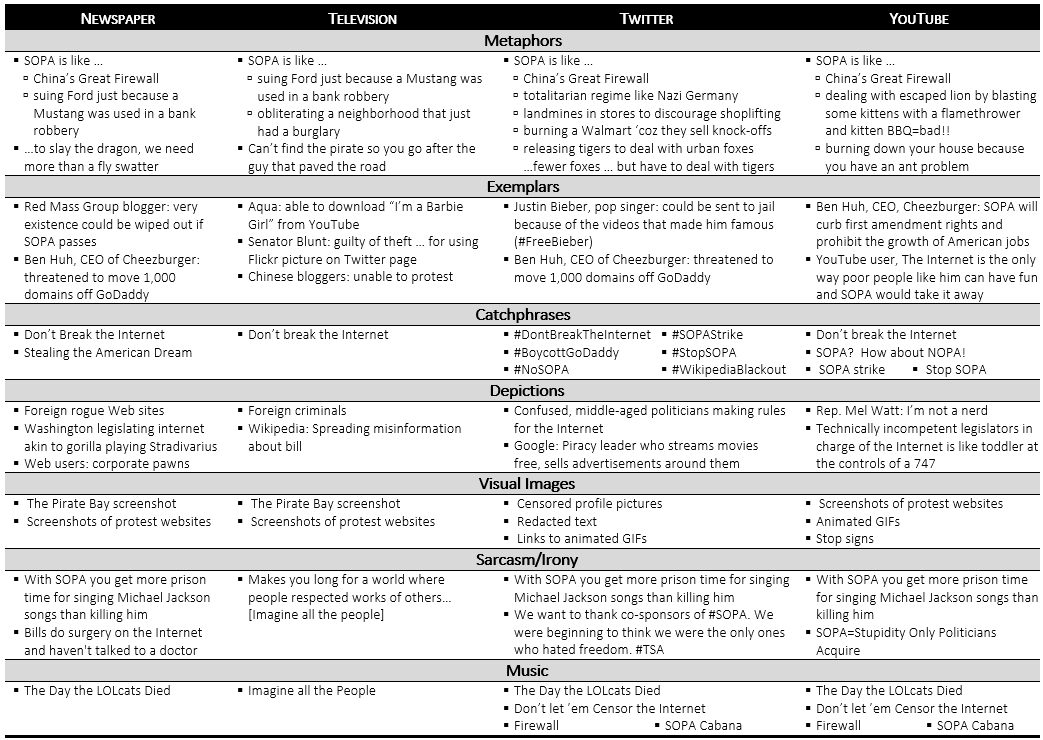
Mass media play an important role in democracies, educating the public, providing a forum for discourse, and shaping public policy. Control of mass media by a few elites, however, is inimical to democracy as it limits the variety of messages disseminated, who can participate in discourse, and what is discussed. Yet, even in democratic countries, mass media is controlled by a few.
In the United States, for example, 90 per cent of traditional news media outlets (newspapers, radio, and television stations) are owned by only six firms, which are controlled by 232 media executives. Similar patterns prevail across European media. Initially a news source for traditional media in locations where alternate sources were unavailable, digital platforms such as Twitter and Facebook seem to be eroding traditional media’s hegemonic lock on public discourse. But is digital media truly a panacea for the ills of mass media concentration? Our study of the Stop Online Piracy Act (SOPA) provides paradoxical answers to this question.
SOPA and associated legislative proposals in the US (e.g., PIPA) and Europe (e.g., ACTA) aimed to curb dissemination of pirated content on the Internet, but also provided media powerhouses the ability to censor speech by claiming copyright violations. The Electronic Frontier Foundation, a digital rights organisation, noted that “SOPA would not just go after copyright infringers; it leaves no one on the Internet untouched”. The proposed legislation polarised organisations and legislators; most traditional media organisations supported it and most digital media organisations opposed it; legislators who received campaign financing from traditional media organisations generally supported it and legislators who received financing from digital media organisations generally opposed it.
Between introduction of the proposal on October 26th, 2011 and Stephen Colbert’s coverage of it on December 1st, 2011, traditional media largely ignored the legislation, despite a flurry of protests from digital rights advocacy groups and prominent Internet organisations. Internet organisations such as the Wikimedia Foundation, tumblr, and Reddit used digital media to disseminate information on the problems SOPA would create and mobilised the Internet community, creating a watershed moment in digital rights as legislators realised that digital media were less susceptible to control.
How did digital media mobilise? In our research, we addressed this question by examining the social structure forged by participants on digital versus traditional mass media and the content of messages disseminated. We studied SOPA coverage across two traditional news media – newspapers and television – and two digital media platforms – Twitter and YouTube.
Structurally, we observed three things (Figure 1). First, there were vastly more participants on digital than on traditional media. While those with a viewpoint on the SOPA legislation needed to be invited by traditional media to share that viewpoint, anyone could share their views on digital media. Second, there was inertia in participation in traditional media discourse – either as authors or sources: those participating early tended to continue participating. This was not the case on digital media though, as participants came and went from the discourse space over time. Third, while many digital media participants were isolated, there was greater inertia in who was influential on the traditional lean medium (newspapers) than on the digital lean medium (Twitter).
Figure 1: Social networks constructed by referencing or citing others across media

Content-wise, we noted two things. First, while there was greater diversity in the ways participants framed the SOPA issue on digital than traditional media, participants on digital media were more apt to omit frames inimical to their interests than were participants on traditional media (Figure 2). Specifically, participants on digital media focused almost exclusively on anti-SOPA frames and were derisive of those sharing a pro-SOPA perspective. Second, while the average traditional media story actually employed a wider range of frame “signatures” – message elements that enhanced the resonance of the frame (Figure 3) – than did the average digital media story, because of the vast number of messages on digital media, anti-SOPA frames diffused quickly across digital media via evocative digital signatures or memes such as visuals (Figure 4) and songs.
Figure 2: Frames shared across media

Figure 3: Types of signature elements or memes used

Figure 4: Some SOPA Protest Visuals

In sum, digital media facilitated public discourse by:
- Promoting widespread awareness about SOPA: Were it not for digital media coverage, the public likely would have had little knowledge about SOPA, since traditional media were not motivated to critique the legislative proposal;
- Permitting a wider segment of the public to engage in the discourse about the legislation and to be heard;
- Propagating more evocative, attention-grabbing messages.
Yet, digital media also encumbered public discourse by constraining the frames sanctioned on digital media, actively discouraging articulation of competing frames. As we embrace the benefits of unfettered digital media, we also need to guard against the public’s potentially irresponsible use of the media. The recent dissemination of false news, culminating in the PizzaGate fiasco, underscores the threat of an irresponsible public. Nevertheless, digital media offer a democratising counterpart to state- or oligopoly-driven traditional mass media, as long as its governance remains neutral and its participation varied.
♣♣♣
Notes:
- This blog is based on the authors’ paper Are Social Media Emancipatory or Hegemonic? Societal Effects of Mass Media Digitization in the Case of the SOPA Discourse, MIS Quarterly Special Issue: ICT and Societal Challenges, Vol. 40 No. X, 2016
- The post gives the views of its authors, not the position of LSE Business Review or the London School of Economics.
- Featured image credit: Ink stained wretches, by Jeff Eaton, under a CC-BY-2.0 licence
- Before commenting, please read our Comment Policy.
 Shaila M. Miranda is Associate Professor of MIS at the Price College of Business, University of Oklahoma. She has a PhD in Management Information Systems from the University of Georgia, an MA in Sociology from Columbia University, and a Master of Management Studies and a BA in Psychology from the University of Bombay. Her research focuses on shared meaning, collective action, and digital innovation. Shaila’s work has appeared in journals such as the MIS Quarterly, Information Systems Research, Journal of Management Information Systems, Small Group Research, and Information and Management. She has served as Senior Editor for Information Systems Research, as Associate Editor for MIS Quarterly, and currently serves on the editorial board for the Journal of the AIS.
Shaila M. Miranda is Associate Professor of MIS at the Price College of Business, University of Oklahoma. She has a PhD in Management Information Systems from the University of Georgia, an MA in Sociology from Columbia University, and a Master of Management Studies and a BA in Psychology from the University of Bombay. Her research focuses on shared meaning, collective action, and digital innovation. Shaila’s work has appeared in journals such as the MIS Quarterly, Information Systems Research, Journal of Management Information Systems, Small Group Research, and Information and Management. She has served as Senior Editor for Information Systems Research, as Associate Editor for MIS Quarterly, and currently serves on the editorial board for the Journal of the AIS.
 Amber Young is Assistant Professor of Operations and Information Management in the Isenberg School of Management – UMass Amherst. Her current research focuses on how ICTs can be used for social good. She is also interested in understanding how digital mass media can be used to shape organizational identity. Amber received her B.S.Ed. in Secondary Mathematics Education from the University of Oklahoma. She received her MBA from Oklahoma Christian University and her Ph.D. from the MIS department of the Price College of Business at the University of Oklahoma. Her research has been published in MIS Quarterly and presented at the International Conference on Information Systems, the Hawaii International Conference on Systems Sciences, the Americas Conference on Information Systems, and the Academy of Management Annual Meeting.
Amber Young is Assistant Professor of Operations and Information Management in the Isenberg School of Management – UMass Amherst. Her current research focuses on how ICTs can be used for social good. She is also interested in understanding how digital mass media can be used to shape organizational identity. Amber received her B.S.Ed. in Secondary Mathematics Education from the University of Oklahoma. She received her MBA from Oklahoma Christian University and her Ph.D. from the MIS department of the Price College of Business at the University of Oklahoma. Her research has been published in MIS Quarterly and presented at the International Conference on Information Systems, the Hawaii International Conference on Systems Sciences, the Americas Conference on Information Systems, and the Academy of Management Annual Meeting.
 Emre Yetgin is an Assistant Professor of Information Systems in the College of Business Administration at Rider University. He received his Ph.D. in Management Information Systems from the University of Oklahoma and his M.B.A. from the State University of New York, Binghamton. His current research spans the fields of business analytics, computer-aided decision making, human-computer interaction, and computer-mediated communication. Within the intersection of these domains, his research focuses on the impacts of technology on how people communicate, process information, and make decisions in various contexts. Professor Yetgin’s research has been published in MIS Quarterly, AIS Transactions on Human–Computer Interaction, and Computational and Mathematical Organization Theory.
Emre Yetgin is an Assistant Professor of Information Systems in the College of Business Administration at Rider University. He received his Ph.D. in Management Information Systems from the University of Oklahoma and his M.B.A. from the State University of New York, Binghamton. His current research spans the fields of business analytics, computer-aided decision making, human-computer interaction, and computer-mediated communication. Within the intersection of these domains, his research focuses on the impacts of technology on how people communicate, process information, and make decisions in various contexts. Professor Yetgin’s research has been published in MIS Quarterly, AIS Transactions on Human–Computer Interaction, and Computational and Mathematical Organization Theory.





